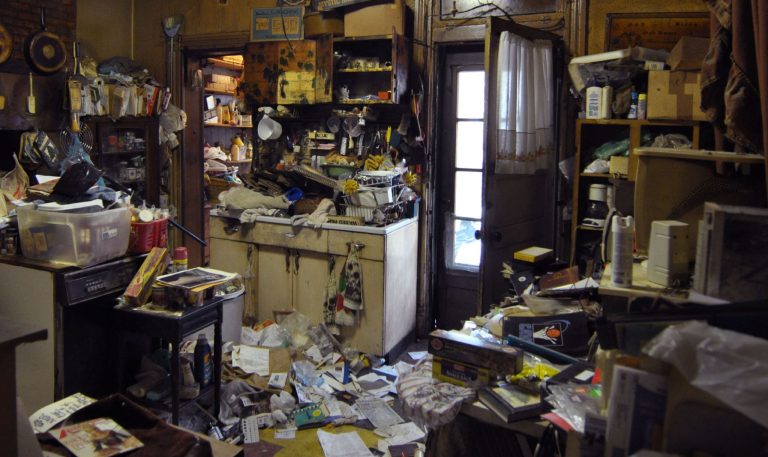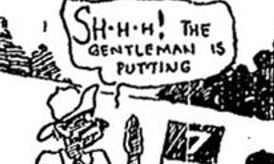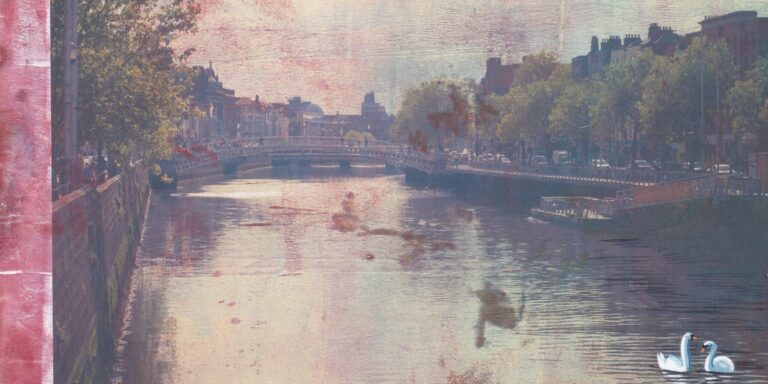

[From an earlier version @ LoOG’s Dutch Courage sub-blog.]
To me, these days, any artist whose work has a resemblance to its actual real-life subject is “conservative,” so too any artist whose sense of beauty corresponds to what is considered beautiful in real life regardless of context.
Above, Beth in White [2006]. Below, Corner of Ripka and Wilde Streets [2010].

Peter’s website is featuring his more recent work such as the latter, and the gentle observer notes a certain evolution in style, toward a less literal and more impressionistic and personal use of line and color.
I relate to PVD’s work not only on the visceral level, that I feel present at the scene, but it’s more than that. His newer work has added impact, and for that first glimpse of the scene, I’m an artist—I’m Peter, the artist—myself. He has lent me his discerning and loving eye, so that I may see what he sees, and feel it as he does.
What a gift, more a sharing really, between artist and audience.
[As a matter of disclosure, Peter Van Dyck is related to me not by blood but by marriage, which is why I’m aware of his work in the first place. Coincidence, or kismet, depending on your view of these things.]
I do hope that possibly tarnishing him with the “conservative” brush does him or his work no fatal disservice. I was shown his earliest work over a decade ago, and even then it made my heart rise—life seemed just a little bit richer for having seen his work.
I’d say if there’s a conservative approach to art and artistry, it’s this—to show us what we strive to see but cannot, the beauty we know in our hearts is there, but lack the clarity of vision to perceive for ourselves.
If there is a conservative view of art, this conservative would put it thus: Where there is no beauty, there is no art.
Ugliness may make a statement; context may enhance, but cannot replace aesthetics. Where there is no love, no love of beauty, but only content and context, there is only propaganda.
A piece of art must be more than its title.
The kind artist, the lover of life and the lover of man, lends us the startlingly clear blink of his eye now and then, although it takes him hours upon hours [and a lifetime of preparation] to get it down onto his canvas.
I have now stood on the corner of Ripka & Wilde and wanted to be nowhere else in creation at that very moment; I have had Beth take my breath away.
For that, to Peter Van Dyck, I am grateful, and shall be all my life.







To me, these days, any artist whose work has a resemblance to its actual real-life subject is “conservative.”
What do you make of Mark Tansey?Report
Jason, where is the love? Consider the entire essay, por favor.
Context isn’t everything, in fact, in the end it’s nothing more than the cherry on top. Michelangelo’s Pieta is stunning in its own right. One need not know the context nor be any more than human to be moved. A Martian or a New Guinean would be moved if not awed: I am sure of this.
A woman holds a dead man in her lap. One can do nothing but weep, along with her.
As for Mark Tansey after a brief sample, the Cow and the Scientists made me laugh. But cleverness is not art. So far, I see nothing but a tragic waste of talent and mastery of craft.
http://www.evl.uic.edu/davidson/CurrentProjects98/ET_VisualInfo/MT_Cow2_p56.gifReport
As an aside, I think the linked Tansey piece is called ‘The Innocent Eye Test’. Other than that little nitpick, thanks for introducing a talented artist.Report
I did consider the entire essay. Liked it, in fact.
If I were to really push back hard, I’d suggest that your view of art is romantic, art-for-art’s-sake, and thus not really conservative. Much of the great art of the Renaissance had even blunter messages than Mark Tansey’s, typically in the service of one political faction or another.
Mark Tansey is indeed talented. I asked about him because his works are almost always representational, realist to surrealist — but very postmodern in their themes. “I represent things,” he seems to say, “therefore you should mistrust me.”Report
Thx, Jason. The second part of the essay is about communication, art as a medium, a bridge between the artist and his audience. I call it “love” as shorthand, but the communication itself [of warm gushy feelings, or outrage, or the pathos of a dead son, doesn’t matter] is at the heart of it. The “beauty” part can be the “value added” by the artist, not that the subject itself is necessarily beautiful.
Again, I was attempting to define what “conservative” art might be. Context turns graphics into propaganda in a goddam hurry. And in the case of Tansey, I think also of Frank Zappa, and the tragedy of glibness and cleverness for their own sake, at the cost of sincerity and visceral human impact.
And I do think there’s a problem in modern art of leaning on the title too heavily. As you recall, the big stink over Duchamp’s “Nude Descending a Staircase [No.2]” was that the artist put the title right on the left hand corner of the canvas.
He was asked to paint over it, but of course refused. Still, I’m glad the custom never caught on. I remain unhappy with titles being necessary to appreciate the work. I like “Nude Descending a Staircase” in its own right and consider the title on the canvas to be a distraction.
Much “conservative” criticism of modern art is of the Emperor’s New Clothes sort, and it is more often deserved than not. Although he was a progressive, Teddy Roosevelt was also a Republican, and of the work he wrote,
“Take the picture which for some reason is called ‘A Naked Man Going Down Stairs’. There is in my bathroom a really good Navajo rug which, on any proper interpretation of the Cubist theory, is a far more satisfactory and decorative picture. Now, if, for some inscrutable reason, it suited somebody to call this rug a picture of, say, ‘A Well-Dressed Man Going Up a Ladder’, the name would fit the facts just about as well as in the case of the Cubist picture of the ‘Naked Man Going Down Stairs’. From the standpoint of terminology each name would have whatever merit inheres in a rather cheap straining after effect; and from the standpoint of decorative value, of sincerity, and of artistic merit, the Navajo rug is infinitely ahead of the picture.”
Ooops, had the wrong “Nude.” This is the right one.
No photo available of the Navajo rug.Report
i find the duchamp painting very beautiful. it’s both human and mechanical, before that was entirely a common theme. i realize he was messing with boundaries – or in modern parlance, “in it for the lulz” – but that makes no difference here.Report
I like this even better.
Everyone must find beauty in some corner of the artistic landscape. I’m glad you’ve found yours.
If you want to confine art to what is beautiful and realistic or moves you personally, well, that’s what art does for everyone. It’s a personal experience. That’s what the artist intended. There’s very little clarity in art, though, even in representational art. It’s always at a one-step remove from life. See, the artist says, here is what I have made.
Over time, if his website is any guide to the matter, Peter Van Dyck’s style has grown more abstract, his palette darker and more limited. He’s outgrown his realistic period. No more Vermeer or Van Gogh quotes in his recent stuff. Could he be growing less-conservative? The nudes are stark and crudely rendered, good stuff, mind you. But it’s clear enough he’s not going back to those sweet portraits any time soon, probably never.Report
I enjoy your analysis of Peter’s work very much, Blaise. That you have the soul of an artist is why you&I have always got along, in our way.
Mighty props for following the links to his website. FTR, I’ve never met Peter. I’ve been moved by his work since I first saw an original canvas he gave to my sister, an early work. When I rediscovered him via the internet while drafting the original essay this OP is drawn from, Beth knocked my socks off. Corner of Ripka and Wilde Streets as well, in a different way.
I’m not a slave to representational art. I like Picasso’s cow [is it a steer?] in Guernica.
It’s cool even if you don’t know it’s about the Spanish Civil War. Mebbe better if you don’t. I get the conflict between men, between man and nature. Being a cow while men are all upset with each other surely sucks. No good can come of it if you’re the cow. [Steerperson.]
It’s OK if I prefer Beth over the cows, in’t it? I don’t need to see her nude, dunno if I relate to her as my younger self, or as the daughter I never had. All I know is that she is beautiful, and her beauty makes me weak at my knees.
Her beauty as rendered by the artist’s hand, mind you—the point of our discussion, yes?Report
Guernica was a test run for the Stuka dive bomber. The screaming horse looks skyward, terrified by the Stuka’s infamous Jericho Trumpet siren, disemboweled by shrapnel, a human skull superimposed over it. The bull stands over the wailing woman and baby.
All faces look up except the bull. Over the painting is the blazing eye of a bare lightbulb. This is happening inside an enclosed room. The spirit of a woman with a candle enters the room, illuminating nothing.
Guernica makes more sense if the viewer has endured a bombing within an enclosed space. The bull is the Minotaur within the Labyrinth, eating its victims, a sword proceeding from its mouth, the dull, stupid violence of an herbivore turned carnivore.Report
I’m all for aesthetic value having primacy over, say, cleverness or coceptual value in art. But not necessarily beauty. What would you say about fiction? Would you say Citizen Kane is not a good work insofar as it shows the ugly falling apart og a man, but is art in virtue of the cinematography?Report
Rose, I’m honored that you reply. The myths are all true. The ones that are not, die before they ever become myths, eh?Report
A fellow will remember a lot of things you wouldn’t think he’d remember. You take me. One day, back in 1896, I was crossing over to Jersey on the ferry, and as we pulled out, there was another ferry pulling in, and on it there was a girl waiting to get off. A white dress she had on. She was carrying a white parasol. I only saw her for one second. She didn’t see me at all, but I’ll bet a month hasn’t gone by since that I haven’t thought of that girl.Report
Where there is no beauty, there is no art.
What’s particularly startling about this perspective to me is what it means for all that which falls outside this narrow aesthetic vision. To me it is like saying only plays written in iambic pentameter are plays, everything else is, well, what exactly? There is a rich diversity of expression that is contained within this particular definition to be sure – so I entirely agree, Pietà, genius – but to overlook entirely the array of art happening outside the beautiful seems like a tremendous missed opportunity. Perhaps there are more challenging choices, but my for instance here would be the Tate Modern’s combination of Monet, Rothko, and Pollock.
Personally, I lean towards both/and, but Marina Abramovi?’s either/or is also worth considering (MoMA)
Report
I like it, Creon Critic, that truth and beauty are not synonymous. I’m familiar with the argument, but I disagree with it.
Shit is truth. We all shit. Is it beautiful? Surely not. So far we’re good.
narrow aesthetic vision
True, beauty is narrow. Ugly is narrow too though: it’s all ugly. Most things either suck bigtime or unworthy of notice as art at all. An infinity of meaningless permutations—which we might charitably call bullshit—clogs up the middle. It is not beauty, it is not art. It’s not even good and ugly. It’s bullshit.
You want to make the case that ugly is art? OK, I can entertain the thought, although achieving ugly is so painfully easier than achieving beauty. Ever watch a diving competition? Anything short of beauty simply doesn’t rate.Report
Beauty is usually an illusion, Tom. You think the World of Most Things is ugly and the shimmering, gauzy (and unfinished) portraiture of Conservative Art is beautiful. You would not be alone in thinking so: most people don’t want to confront the reality of their own lives.
But for those of us who look to art for some semblance of meaning in our lives do not wish to retreat into some idyllic world where the sun always shines just so on that little corner of Philly at Ripken and Wilde. There are four sets of windows on the first floor of that building, not two. Three windows on the second story, not one. I’m looking at it now in Google Street View.Report
I hear you, Blaise. But beauty is beauty and everything else is shit. A provisional law of aesthetics, submitted for your consideration. Dunno about you but I’m up to my eyebrows in shit. I need me some beauty.Report
In which I agree with Tom, perhaps for the first time.
Beauty, is in and of itself deep and profound and meaningful. Beauty is mysterious and has a power that levels the playing field between scholar and novice; who can explain exactly why we find this still life beautiful, and that one dull?
Beauty resists being captured by a narrow priesthood of experts and scholars; all the education in the world can’t produce a Mozart, and yet a beautiful song can be produced by a illiterate housewife.
A beautiful work of art doesn’t accurately protray the world, it re-presents it. It causes us to see things in a different way. The fact that it looks normal, but isn’t normal, is what gives it a power that abstraction doesn’t normally have.Report
Francisco Goya, Saturn Devouring His Son. Beautiful? Same artist, Los Caprichos. Beautiful?
Perhaps this is a better way of saying it, saying that all art must be beautiful is like saying every novel must have a happy ending. Novels with triumphant protagonists aren’t lesser works in and of themselves for the fact, but one misses important features of a world that is at turns beautiful, but also cruel, unforgiving, and downright brutal in focusing so closely on beauty.
For a while I had a sense a great deal of contemporary art was artists, curators, and critics talking amongst themselves in a language that leaves everyone else, including me, out. And I’d say being told so-and-so is a Very Important Artist, or Art History Has Decided X, Y, and Z, is a lot less convincing than going to the Whitney, or MoMA, or the Tate Modern and particular works evoking (or provoking) feelings and emotions themselves. I suppose this is how religious people feel when they tell atheists they’re missing something by not having faith. For me, artists and artworks have much more to say than a focus on those things related to beauty allows, engaging with the wider world in the ways Marina Abramovi? mentions.Report
Creon Critic, perhaps you should assess “beauty” before continuing. [Am enjoying your input.]
Michelangelo’s Pieta is the antithesis of the happy ending.Report
How very true. The Pieta is also the end of an era where art stood independent of the artist. Upon hearing some critics discuss who had actually carved it, Michelangelo picked up his chisels and carved MICHAELAGELUS BONAROTUS FLORENTIN FACIEBA upon a ribbon on the Virgin.
It would be the only work he ever signed. Couldn’t even spell his own goddamn name right. Wretched Latin, too.
The artist is not the art. Sooner we get that bit right, we can dispense with all this horseshit about Good Art and Bad Art.Report
“The artist is not the art. ” Exactly. The “artist” as a person is just more context.
“Art stood independent of the artist.” And of context. Exactly.
I like Peter Van Dyck’s work. Hadn’t been back to his website since I drafted the original sub-blog OP. Love the new stuff too. Can’t wait to see what he does with cows.Report
Cowsies and horsies are sorta like Freud’s Cigar. I still don’t see why you divide the world up into Beauty and Shit. Though every living thing shits something or other, it’s not really so terrible, as anyone who’s changed a diaper will tell you. It’s not like shit is radioactive, though my son passed some amazingly terrible stuff, God alone knows what he was eating.
Me, I used to photograph wrecked things, buildings about to go under the wrecking ball, old rusty cars and suchlike. I photograph in weedy graveyards and glorious old theatres alike.
You might not call this sort of thing Art. Not sure I would, either. I’ve learned, over time, to record what mattered to me along the way. A good deal of my life has been lived looking in the rear view mirror, back at places and people I loved.
When Picasso set out to paint The Dream of Franco and his Lies, he wasn’t trying to capture Beauty. He was reacting to his world, doing what came naturally. Like shitting. Like grieving. Like being angry.
Retreat into beauty if you’d like, I spend a good deal of my life looking into a camera viewfinder, trying to preserve something important to myself, knowing I can only walk away with an image. He who goes in search of Truth will often find Beauty in the rubble of what others have judged Ugly, the roses in the desert.Report
Blaise, you’ve just let me escape the box you’ve been trying to pound me into.Report
Shrug. If you are in a box, it is of your own devising.Report
But you’d hardly call it ugly, would you?Report
Fair point. I was thinking we might run into difficulty over terms. I’d argue in my defense, look at the way the Pieta is presented, flesh and fabric made of marble so exquisitely. Bernini’s Rape of Proserpina also isn’t such happy subject matter, but again the sheer skill with marble that I’m just lodging those sculptures into the beautiful category.
I’m curious as to how you categorize the other not-quite-art stuff, conceptual artists engaging with things like America’s racial history. If they aren’t artists are they opinion writers with particularly wide-ranging mediums? Or how you’d categorize the work of sculptors like Richard Serra and Anish Kapoor?
All over reliant on context and thus “only propaganda”?Report
Shit is *Real* which is different sort of thing than Truth. (or Beauty)Report
Mr. Kolohe, I give you Anish Kapoor’s Between Shit and Architecture.
I agree.Report
Part of the issue is that ever since cameras became consumer-grade items rather than specialty equipment that required significant investment and years of trade-skill training, the idea of illustration-as-art has been lost. Why bother painting a realistic picture of something when you can just take a photograph?Report
But that might cause just the opposite… ANYONE can have a photograph of the Manhattan skyline or Rocky Mountains… not everyone can create or acquire a remarkable painting of them.Report
Indeed. My wife has made (and sold) a few portraits in colored pencil from photographs.Report
Lots of artists paint realistic pictures because a painting is not the same thing as a photograph. The impulse to create art is not generally based on such pragmatic considerations.Report
Smile Dog — when composting becomes art, and art becomes meme.Report
Where there is no beauty, there is no art
Supposing that we disagree about what is and isn’t beautiful, what decides the issue?Report
Normal people have very little disagreement. There is a natural law of aesthetics, see Aristotle, Aquinas, Jacques Maritain.
One has to join the cult of modernity, the Emperor’s School of New Clothes, to unlearn the impulse toward beauty and learn to love ugliness, to value the worthless, find meaning in the meaningless.
The power of words to seduce the human mind is great; hence the reliance on titles, on context, on explanation. True art is self-explanatory; modern art largely relies on being accompanied by an instruction booklet, the who, the what, the why. As Adam Smith notes in his wise and wonderful The Theory of Moral Sentiments, we only approve of actions when we approve of the motives behind it.
In the cult of modernity, we approve of the art when we approve of the artist and his motives.
After the Hunt by Ted NugentReport
“Normal people have very little disagreement.”
That’s a cop-out. You’re essentially classing yourself with normal and everyone who disagrees as abnormal. But we all tend to think of our views in this way; it isn’t us who is weird, but everybody who isn’t us. I don’t think there’s anything substantive to be taken from such a claim other than a desire to conflate your own views with larger, factual truths that don’t actually exist.Report
Normal people get the joke.Report
So it is your position that beauty is objective?Report
See Maritain [link above], get back to me. Going out to play a gig. It’s only rock’n’roll but I like it. Peace.Report
(1) How is dismissing Maritain’s thought as mental masturbation in the service of one’s prejudices any different from your offhand dismissal of Kapoor’s and (the surprisingly talented) “Ted Nugent’s” work? (I love the way Nugent suggests the proud-in-death stag)
(2) If you haven’t already read it, you might enjoy Tom Wolfe’s The Painted Word. Academicians hate it. Others might enjoy it, as well.
(c) Rock’n’roll, eh? Why not try playing real music some time (get the joke?)?
(4) I knew Sam would turn up before the thread went dead. Hi Sam!Report
Mr. Van Dyke:
I haven’t had time to comment, but I consider this a good thing for moi. (Rumination is always my friend.) And so I have two questions for you, ranked in order of importance:
1. Why do you even feel compelled to descriptively categorize art, specifically art that you find engaging and moving, as “conservative”?
2. Why are y’all spelling your last names differently when you’re related? (This isn’t a criticism, just a passing curiosity on my part.) Ellis Island stuff, or something else?Report
Ms. Ward, Mr. Kain and LoOG have been kicking [around?] “conservative” art for months. This was my assay of the landscape, and it occurred to me that Peter’s art is somewhat out of fashion, out of the mainstream, if you will, of “professional” art.
[He is, however, an assistant professor @ the Pennsylvania Academy of the Fine Arts.]
So I made Peter the kickoff point, in no small part because I am indeed moved by his work, and pretty much unmoved by “modern” art on any visceral, human level. For reasons given above, that it relies on titles, cleverness, and context.
Words. Words that have nothing to do with the art itself, which I have suggested should be, for the most part, self-explanatory.
Much of what I’ve written here are my own ruminations on the subject of “conservative” art, a coinage for a concept that had never occurred to me except as a vague sense of “Not-modern.” I’ve also been meaning to get into Maritain on aesthetics, and this was an excuse to do some reading up on that. [Thomist that I am.]
As for Van Dyck vs. Van Dyke, Peter and I are related by marriage. My sister married Peter’s father. BTW, it’s Peter’s family legend that his bloodline includes the Dutch Master Anthony Van Dyck. I have no reason to disbelieve it. How ’bout you?
“I am […] pretty much unmoved by “modern” art on any visceral, human level. For reasons given above, that it relies on titles, cleverness, and context.”
I read no reasons above other than a citation of Duchamp’s writing a title on his painting (a painting you claim to like, may I remind you). When challenged to comment on Los Caprichos, many of which contain their titles, you suggested that Creon Critic needs to “assess beauty” — whatever that’s supposed to mean.
You did an admirable job of describing your appreciation of Van Dyck’s work, why waste space with an unreasoned attack on art you don’t like? (A reasoned attack would be fine, btw, this just didn’t happen to be one). De gustibus non disputandum est, don’t forget.Report
I do not stipulate that it is art; it’s between shit and architecture, as advertised.
Between Shit and Architecture by Anish KapoorReport
Lame dodge.Report
No, you dodged, sir. I don’t blame you, though.Report
Not only do I not remember dodging, I don’t even see where I had an opportunity to dodge. Please enlighten.Report
Hmph. I’d have pictured Conservative art as Romantic, and Liberal art as the opposite.
I do believe you do the artistic world a VAST disservice by using what lies in art galleries as the be all and end all of art.
Video games, to a large degree, strive to create realism. And they’re a lot more popular than art galleries.Report
Nobody would call Soviet-era artwork A: Conservative or B: unromantic. (Unless you believe that either life-fulfillment through hard work and self-sacrificing communitarian conformity are not conservative values, or that the Soviet Union was not Conservative in its ideology.)Report
Pretty much everyone in the art world would call Social Realism conservative — it’s about the art, not the politics.Report
Agreed. Social Realism is about as conservative as art can get. And as anti-communist as I am, I still find some of it quite wonderful.Report
Hear, hear. I had a Chinese refugee prof back in the seventies who loved Maoist posters — without irony (contemporary irony, that is; there might have been a touch of old-fashioned irony there).Report